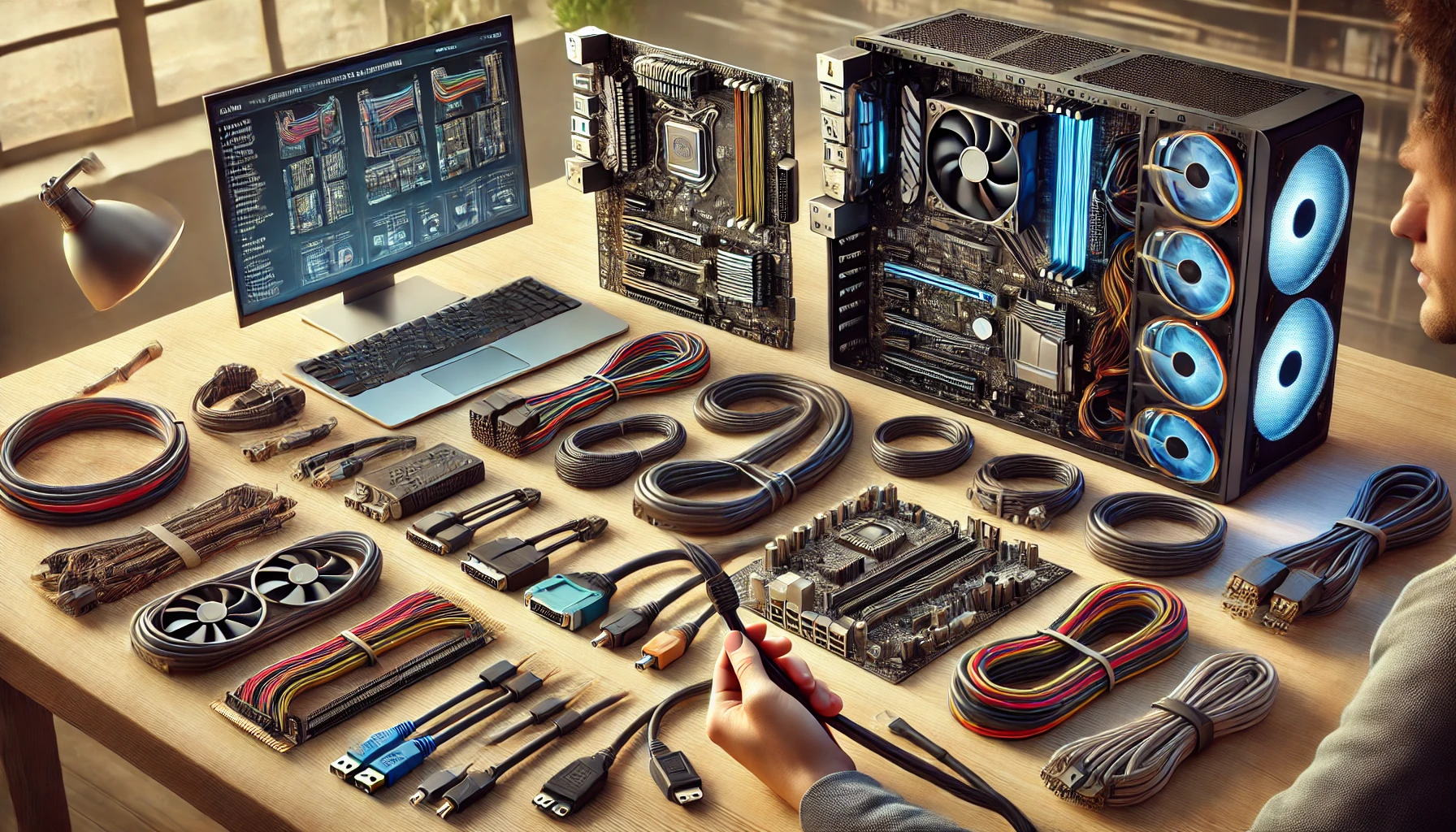When building or upgrading a PC, most people focus on the major components—CPU, GPU, RAM—but often forget about one crucial detail: cables and adapters. Without the right cables, even the best hardware won’t work correctly. And in 2025, with new connectors and standards like USB4, PCIe 5.0, and 12VHPWR, choosing the right cables is more important than ever.
In this guide, you’ll learn how to select the correct power, data, display, and adapter cables for your PC—ensuring a clean, compatible, and fully functional setup.
Why Cables and Adapters Matter
- Prevent hardware incompatibility
- Ensure stable power delivery
- Avoid signal loss or performance bottlenecks
- Keep your setup clean and organized
- Avoid damage from low-quality or mismatched cables
Cables may not be exciting—but choosing the wrong one can cause crashes, poor performance, or even component failure.
1. Power Supply Cables
Your PSU provides power to your motherboard, CPU, GPU, storage, and more. Make sure it includes:
- 24-pin ATX power cable (for motherboard)
- 8-pin (4+4) EPS cable (for CPU power)
- PCIe 6+2 pin or 12VHPWR cable (for GPU)
- SATA power cables (for SSDs, HDDs, fans, RGB controllers)
- Peripheral/Molex cables (used for legacy fans, pumps, accessories)
Modern GPUs (like the RTX 4070/4080/4090) often require 12VHPWR (16-pin) cables. Only high-quality, recent PSUs include these.
💡 Never use low-quality 12VHPWR adapters—they can overheat or melt.
2. Motherboard Front Panel and Internal Cables
- Front panel connectors: tiny wires for power button, reset, and LEDs
- USB 3.2 Gen 1/2 header cables: for front USB-A ports
- USB-C (Type-E) cable: for front-panel USB-C support
- HD Audio cable: for front headphone and mic jacks
- ARGB/RGB headers: for case lighting and fan LEDs
Always match the case’s cable connectors with the headers available on your motherboard.
💡 If your case has USB-C but your motherboard doesn’t support it, that port won’t work unless you use an internal USB-C adapter.
3. Display Cables
For connecting your PC to a monitor, choose a cable that supports the resolution and refresh rate of your display.
Common video cable types in 2025:
- HDMI 2.1: Supports 4K 120Hz or 8K 60Hz; great for TVs or newer monitors
- DisplayPort 1.4 / 2.0: Preferred for high refresh rates (144Hz–240Hz+)
- USB-C (with DisplayPort Alt Mode): For laptops or single-cable docking setups
- DVI / VGA: Outdated and not recommended unless required for old monitors
💡 Always use a certified cable rated for the resolution and refresh rate you need. Cheap HDMI cables may not support 4K 120Hz even if labeled as such.
4. Storage and Data Cables
Most modern storage devices connect using:
- M.2 NVMe SSDs: No cable needed; they connect directly to the motherboard
- SATA SSDs/HDDs:
- SATA power cable (from PSU)
- SATA data cable (from motherboard)
If your motherboard has only a few SATA ports, consider a SATA expansion card.
💡 Use SATA 3 cables for maximum data speeds (6Gb/s).
5. USB and Peripheral Cables
For connecting external accessories like webcams, printers, or audio interfaces, use the correct USB standard:
- USB 2.0: Good for keyboards, mice, and simple peripherals
- USB 3.0 / 3.1 / 3.2: High-speed devices like external SSDs
- USB4 / Thunderbolt 4: Extremely fast; ideal for external GPUs, docks, and high-end displays
💡 Check if your motherboard or case supports USB4 or Thunderbolt 4 before investing in those cables or devices.
6. Ethernet (Networking)
Use Cat6 or Cat6a cables for wired internet connections. They support gigabit and 2.5G+ speeds with good shielding and low interference.
- Cat5e: Works for up to 1Gbps (older)
- Cat6: Ideal for most users
- Cat6a / Cat7: Better shielding; ideal for future-proofing
💡 Avoid ultra-cheap Ethernet cables—they may throttle your internet speed or degrade over time.
7. Audio and Display Adapters
Sometimes you’ll need adapters to match your monitor or speaker setup.
Common examples:
- DisplayPort to HDMI
- USB-C to HDMI
- HDMI to DVI
- 3.5mm to RCA (for speakers)
- USB DACs (digital to analog audio conversion)
💡 When using adapters for high-res video (4K+), choose active adapters that support full resolution and refresh rate.
8. Cable Management Accessories
Keeping cables neat isn’t just about looks—it also improves airflow and makes future upgrades easier.
Useful accessories:
- Velcro cable ties or zip ties
- Cable combs (for sleeved cables)
- Cable routing channels (built into most cases)
- Motherboard cable covers
- Cable extensions (to improve appearance in glass-sided cases)
💡 Don’t over-tighten zip ties—it can pinch cables and cause damage.
9. What to Avoid
- Cheap no-name 12VHPWR adapters for GPUs
- Old or unshielded SATA and USB cables
- Adapters from low-rated brands with poor reviews
- Long, thin video cables over 3 meters without certification
- Mixing Molex and SATA with Y-splitters on high-power devices
Poor-quality cables are one of the leading causes of hardware damage and system instability.
Final Thoughts
Cables and adapters are easy to overlook—but they’re essential to building a functional, reliable, and clean PC. With the right knowledge, you can avoid compatibility issues, maximize performance, and keep your build organized.
Always match cable specs to your hardware requirements, invest in quality materials, and plan cable routing during your build process. A little planning goes a long way.
